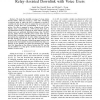Free Online Productivity Tools
i2Speak
i2Symbol
i2OCR
iTex2Img
iWeb2Print
iWeb2Shot
i2Type
iPdf2Split
iPdf2Merge
i2Bopomofo
i2Arabic
i2Style
i2Image
i2PDF
iLatex2Rtf
Sci2ools
100
click to vote
GLOBECOM
2006
IEEE
2006
IEEE
Power Allocation and Coverage for a Relay-Assisted Downlink with Voice Users
— We study the downlink coverage of a base station terminal (BST), which has access to a relay node. Continuing a previous study in which the BST is assumed to provide a variable-rate data service, here we assume that each active user requires a target data rate, corresponding to a voice type of service. The relay is assumed to serve a separate set of (noncellular) users, corresponding to a WiFi Access Point (AP). A one-dimensional model is considered in which cellular and noncellular users are uniformly distributed along a line. The BST and AP jointly allocate available power across users and the BST-AP link to maximize the total number of users served. We characterize the optimized set of active cellular users served by the BST directly and the AP relay, and the non-cellular users served by the AP. We also give a closed-form upper bound on the increase in the total number of users provided by the relay as a function of user densities and path loss exponents. Our results show that d...
| Added | 11 Jun 2010 |
| Updated | 11 Jun 2010 |
| Type | Conference |
| Year | 2006 |
| Where | GLOBECOM |
| Authors | Junjik Bae, Randall Berry, Michael L. Honig |
Comments (0)

